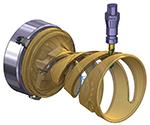
CNC Software, LLC, developer of Mastercam, the world’s leading CAD/CAM software, announces the release of Mastercam 2023.
Manufacturers worldwide got the chance to test-drive Mastercam 2023 during the Public Beta Program before it was released and provided valuable feedback to help shape the final 2023 product. Many of the improvements in Mastercam 2023 are directly driven by Mastercam users and shops. Feedback from Public Beta releases, shop visits, customer surveys, and consultation with our expert industry partners create the practical, shop-driven focus that helps ensure Mastercam users’ success.
Expanding and Consolidating Multiaxis Toolpaths. The new Unified Multiaxis toolpath brings together Morph, Parallel, Along Curve, and Project Curve strategies into a single interface, delivering expanded and highly flexible cutter path creation. The Unified toolpath allows access to these cut patterns when you add the appropriate curves. For example, to create a toolpath that morphs between two surfaces, select Unified from the Multiaxis toolpaths, and then set the Cut Pattern to two surfaces with the Morph style. The Unified toolpath allows for more flexibility in cut pattern when programming in Multiaxis.
New B-Axis Contour Turning Toolpath. Mastercam 2023 introduces a new toolpath to the Turning suite for the Mill-Turn product. B-Axis Contour Turning is a finishing toolpath that allows for rotation of the B-axis while the tool is cutting. The toolpath features a top-down workflow and provides you with either Automatic or Manual motion control. Automatic mode produces safe toolpath motion that keeps the insert in contact with the contour. Manual mode offers full control over the B-axis angles along the contour. Areas that would have taken multiple tools and resulted in blends are now possible with one single toolpath, resulting in superior finish, fewer tool changes, and less cycle time.
Detecting Undercut Stock When Machining. The Dynamic OptiRough and Area Roughing toolpaths can now be aware of undercut stock conditions, resulting in improvement to the toolpath motion, including less air cutting.
Machine Group Setup. Mastercam 2023 introduces the new Machine Group Setup function panel for Mill and Router machine groups. This panel encompasses features and functionality from the Machine Group properties dialog box, including new features. Machine Group Setup provides a clean, modern interface to define stock, material properties, workholding, tools, and simulation settings. Accessing all of the critical components of setting up a job, from stock to simulation, has never been easier or more organized.
Contact Details
Related Glossary Terms
- computer numerical control ( CNC)
computer numerical control ( CNC)
Microprocessor-based controller dedicated to a machine tool that permits the creation or modification of parts. Programmed numerical control activates the machine’s servos and spindle drives and controls the various machining operations. See DNC, direct numerical control; NC, numerical control.
- milling machine ( mill)
milling machine ( mill)
Runs endmills and arbor-mounted milling cutters. Features include a head with a spindle that drives the cutters; a column, knee and table that provide motion in the three Cartesian axes; and a base that supports the components and houses the cutting-fluid pump and reservoir. The work is mounted on the table and fed into the rotating cutter or endmill to accomplish the milling steps; vertical milling machines also feed endmills into the work by means of a spindle-mounted quill. Models range from small manual machines to big bed-type and duplex mills. All take one of three basic forms: vertical, horizontal or convertible horizontal/vertical. Vertical machines may be knee-type (the table is mounted on a knee that can be elevated) or bed-type (the table is securely supported and only moves horizontally). In general, horizontal machines are bigger and more powerful, while vertical machines are lighter but more versatile and easier to set up and operate.
- parallel
parallel
Strip or block of precision-ground stock used to elevate a workpiece, while keeping it parallel to the worktable, to prevent cutter/table contact.
- toolpath( cutter path)
toolpath( cutter path)
2-D or 3-D path generated by program code or a CAM system and followed by tool when machining a part.
- toolpath( cutter path)2
toolpath( cutter path)
2-D or 3-D path generated by program code or a CAM system and followed by tool when machining a part.
- turning
turning
Workpiece is held in a chuck, mounted on a face plate or secured between centers and rotated while a cutting tool, normally a single-point tool, is fed into it along its periphery or across its end or face. Takes the form of straight turning (cutting along the periphery of the workpiece); taper turning (creating a taper); step turning (turning different-size diameters on the same work); chamfering (beveling an edge or shoulder); facing (cutting on an end); turning threads (usually external but can be internal); roughing (high-volume metal removal); and finishing (final light cuts). Performed on lathes, turning centers, chucking machines, automatic screw machines and similar machines.
- undercut
undercut
In numerical-control applications, a cut shorter than the programmed cut resulting after a command change in direction. Also a condition in generated gear teeth when any part of the fillet curve lies inside of a line drawn tangent to the working profile at its point of juncture with the fillet. Undercut may be deliberately introduced to facilitate finishing operations, as in preshaving.
